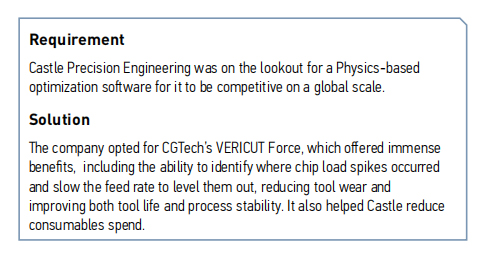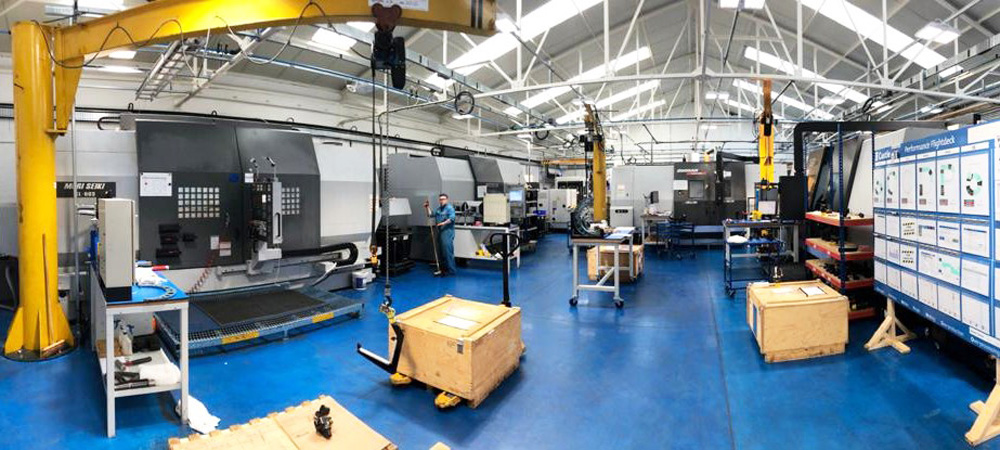Competing on a Global Scale

Castle Precision Engineering has been using CGTech’s VERICUT CNC simulation software for many years, protecting high-value customer components as well as its own advanced machine tools. The company has now embraced the efficiency and productivity gains offered by the Force module of the software.
While Castle supports a number of advanced industry sectors, such as Medical Devices and Power Generation, the majority – around 90 percent – of its circa £20m annual turnover comes from the Aerospace and Defence sectors. To cater to the diverse needs of its customer base, there are three focused sub-divisions that encompass what the business has to offer: Rotatives, Prismatics, and Toolroom.While Castle supports a number of advanced industry sectors, such as Medical Devices and Power Generation, the majority – around 90 percent – of its circa £20m annual turnover comes from the Aerospace and Defence sectors. To cater to the diverse needs of its customer base, there are three focused sub-divisions that encompass what the business has to offer: Rotatives, Prismatics, and Toolroom.
Roy Yuile, Manufacturing Engineering Manager, Castle Precision Engineering, explains: “Rotatives and Prismatics are the two core areas of our production business, and both require extremely high levels of precision and machining expertise. Over the years, we’ve carved out a niche for ourselves in manufacturing critical rotating parts for the aero engine market—failure of these parts can bring an airplane out of the sky, so our OEM customers are not only trusting us with their reputations but also with the safety of the pilots and passengers whose flights they power. We also manufacture a wide range of complex prismatic products to very exacting tolerances for applications such as defence optronics and hydraulic actuation systems for control surfaces and landing gear.”
Prismatic parts are typically machined from relatively straightforward materials, primarily aluminum alloys, along with some steel and titanium. However, rotating aero-engine components usually involve more exotic and difficult-to-machine materials, including titanium and nickel-based super alloys, where forgings valued up to US$100,000 for a single workpiece are not uncommon.
With a population of around 60 CNC machine tools representing the latest multi-axis manufacturing technology from DMG Mori, Makino, Doosan, and Grob, the shopfloor at Castle is a lesson in housekeeping and efficient organization for all to see. Looking more like a cleanroom than a workshop, it highlights what a class-leading aerospace supplier should strive to achieve and creates an environment that nurtures professional behavior at every level. VERICUT, a safety net
VERICUT, a safety net
Protecting this advanced manufacturing capability is VERICUT CNC simulation software. Yuile says: “CAD is at the front end of our engineering workflow – we either import a 3D model supplied by the customer or draw one up from a 2D definition and break this down into the various stages of manufacture, from material supply to finished part. These stage models and their accompanying fixtures or workholding devices are transferred to CAM, where we build tools, generate toolpaths, post NC code, and then port the whole job straight into VERICUT using their CAM interface.”
He continues: “VERICUT has been an established part of our workflow for over a decade – nothing goes out to a machine without first going through VERICUT, and that is across the board. It is an essential safety net, not just for the product but also for our machines and personnel. We have some programs in our factory that have been around for 10 or 20 years, alongside jobs that are fresh out of CAM. We use VERICUT to simulate any new or modified code before it goes out to a machine. We have a digital twin for almost every machine tool, and because VERICUT reads the same G-code as the machine controller, it’s completely CAM-agnostic and can simulate code from any source.”
Very often, process improvements are made using VERICUT because the software offers the opportunity to prove edits in a virtual environment. “We don’t edit at the machine console because of the risk involved,” Yuile adds, “If you mess up, you have no safety net. Instead, our engineers bring the code back into VERICUT, make their edits, and then hit simulate to check that the program is safe to release. Smashing pixels is much cheaper and safer than writing off a machine tool, so verifying code using a digital twin before we put anyone or anything at risk is an integral part of our workflow. This risk-based approach is absolutely crucial, not just in aerospace and defence, but for any high-value product and business.”
With VERICUT an established part of Castle’s business for the past 12 years, the software has proven its ability to protect the company as well as being a key improvement tool for its manufacturing processes.
May the Force be with you
With VERICUT an established part of Castle’s business for the past 12 years, the software has proven its ability to protect the company as well as being a key improvement tool for its manufacturing processes. Yuile states: “VERICUT Force is a step further along this curve. Moving beyond the goalkeeper functionality, Force allows us to start optimizing our processes as well as proving that they are safe.”
Every manufacturing business faces the same three challenges from its customers: quality, delivery, and cost. “Generally, quality and delivery are a given, and cost is where we win or lose,” he says. “The pressure within the Aerospace industry on cost is enormous, and for us to stand against global competition, we have to be smarter, faster, and more efficient. Physics-based optimization software has been on our radar for a while, and we started looking at it seriously a couple of years ago.”“There are a few key players in that market, and we evaluated them all. There’s a lot of clever math behind it, but the basic idea of physics-based optimization is to analyze a toolpath line by line, calculate the forces acting on the cutting tool at any given point in time, and then adjust the feed rate to balance or control that force and chip load,” he adds.
“This means there’s a lot of number crunching involved, but before you even get there, you need to build an accurate digital model of the machining process. Since we already simulate every job in VERICUT, the major advantage of VERICUT Force is that building this model takes almost no additional effort – all Force needs is a bit more information on tool geometry and material characteristics; everything else is already there. The cycle time savings you can expect to get from this kind of optimization are typically 10-20 percent, and VERICUT offered an almost ‘plug and play’ solution for both milling and turning that was really attractive to us,” adds Yuile.

User-friendliness wins
During the evaluation phase, the engineering team at Castle worked with CGTech UK to create a test case based on an existing process involving both turning and milling, which was provided to multiple software vendors. As Yuile points out, “To be honest, they all came back with broadly similar results for cycle time reduction, but it was the usability that was the differentiating factor for us. We have everything built up in VERICUT already, and because CGTech has done a really good job of making Force as user-friendly as possible, it helps make the benefits of physics-based optimization a lot more accessible.”
He says: “It is exciting, the idea that we can go through our existing workflow, take a job that we have proven as a stable process, and then say, ‘Right VERICUT, analyze this for me and tell me where there’s room for improvement’.”
“The interesting thing is because we are working with a lot of difficult-to-machine materials, it’s not always about cycle time. It sounds counterintuitive, as typically, the main benefit of optimization is the opportunity to speed things up, but sometimes it’s also about slowing things down to reduce peak loading on the tool. Smoothing out spikes in cutting force or chip load can have a major effect on tool life, but it is harder to quantify the benefit as you can’t tell until you go and try it,” he adds.
“On one of the jobs we were analyzing recently, we were looking at a histogram of chip load and seeing that for maybe 5 percent of the time it was twice as high as the average load, telling us that there were regular spikes throughout the tool path. Now we have the ability to identify where these occur and slow the feed rate to level them out, reducing tool wear and improving both tool life and process stability.”
Castle has everything built up in VERICUT already, and because CGTech has done a really good job of making Force as user-friendly as possible, it helps make the benefits of physics-based optimization a lot more accessible.
Reducing consumables spend
Force has been in use at Castle for about a year, and Yuile is keen to highlight one of the often-overlooked benefits—consumables spend. He says: “Carbide cutting tools are a major expenditure for us. When we are costing a job, the two key variables are how long it is going to take on the machine and how much we are going to consume in carbide. Any reduction in cycle time Force can deliver is good, but so is any improvement in tool life.”
“Although cycle time is a monetary saving in the sense that you free up machine capacity that you can sell to somebody else, consumables are direct cash spend. If it takes £100 of carbide to make a particular part and we can reduce that to £80, we are literally not spending £20. That’s £20 that stays in our bank account. Cycle time savings are soft money; they’re potential revenue, while consumables spend is hard money; it’s cash.”
Partners in progress
Castle has always been an early adopter of manufacturing technology, and VERICUT has established itself as an essential part of the company’s digital workflow. “We put a lot of effort into ensuring our simulations are an accurate representation of the real process, as the benefits VERICUT delivers are massive, both as a safety net and as an improvement tool. All of our programming is done offline, and being able to accelerate the proving out of new jobs by doing most of it virtually saves a huge amount of production downtime, as well as derisks the entire process.”
“We trust VERICUT,” Yuile concludes, “and that trust comes from experience. When manufacturing high-value components for such critical applications, we need to have confidence that we’re using the very best tools for the job, and VERICUT delivers.”
Castle Precision Production CellSource: CGTech
Source: CGTech




 Facebook
Facebook.png) Twitter
Twitter Linkedin
Linkedin Subscribe
Subscribe